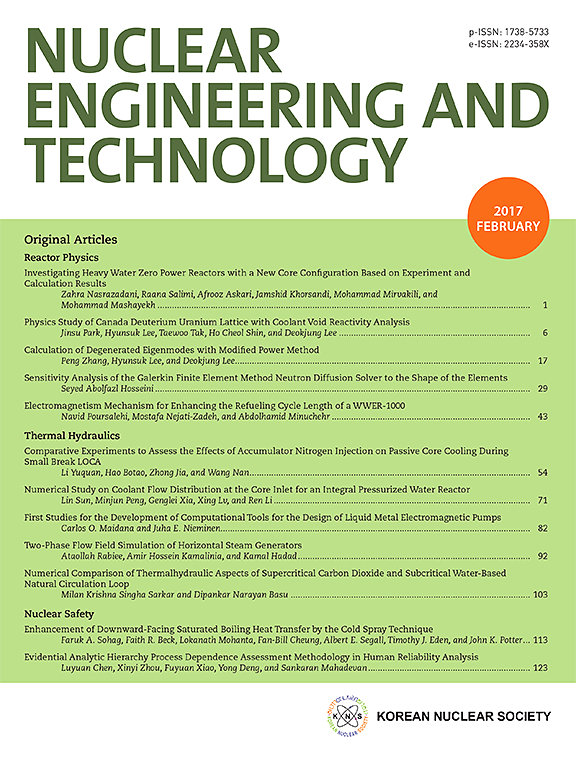Unveiling the potential of Nd2O3 in optimizing the radiation shielding performance of B2O3–TiO2–BaO–ZnO-Nd2O3 glasses
IF 2.6
3区 工程技术
Q1 NUCLEAR SCIENCE & TECHNOLOGY
引用次数: 0
Abstract
This research focuses on the preparation of a new glass system designed specifically for applications in radiation shielding materials. These glasses are based on the general formula (56-x)B2O3–10TiO2–8BaO–27ZnO-(x-1)Nd2O3, where x takes the values of 2, 4, 6 and 8 mol%. For the examination of the designed glasses' radiation attenuation performance, Phy-X software was used, which is a useful approach for predicting the linear attenuation coefficient (LAC), the half value layer (HVL), and effective atomic number. The LAC decreases from 1.489 cm−1 to 0.551 cm−1 for the glass with x = 1 mol%, while the glass with 7 mol% Nd2O3 saw a decrease in the LAC from 2.483 cm−1 to 0.718 cm−1. Introducing Nd2O3 increases the glasses' LAC, suggesting enhanced radiation shielding performance. Also, Nd2O3 addition influences the HVL within the glasses, with higher content reducing the HVL. At 0.122 MeV, the HVL and tenth value layer (TVL) are 0.456 and 1.546 cm, respectively. At 0.245 MeV, the TVL is about 3.32 times higher than the HVL. The lowest mean free path (MFP) is found at 0.122 MeV, which varies between 0.672 cm for Nd1 and 0.403 cm for Nd4.
揭示 Nd2O3 在优化 B2O3-TiO2-BaO-ZnO-Nd2O3 玻璃辐射屏蔽性能方面的潜力
这项研究的重点是制备一种专门用于辐射屏蔽材料的新型玻璃系统。这些玻璃的通式为(56-x)BO-10TiO-8BaO-27ZnO-(x-1)NdO,其中 x 的值为 2、4、6 和 8 摩尔%。为了检测所设计玻璃的辐射衰减性能,使用了 Phy-X 软件,该软件是预测线性衰减系数(LAC)、半值层(HVL)和有效原子序数的有效方法。x = 1 摩尔%的玻璃的线性衰减系数从 1.489 厘米降至 0.551 厘米,而含有 7 摩尔% NdO 的玻璃的线性衰减系数则从 2.483 厘米降至 0.718 厘米。引入氧化钕可增加玻璃的 LAC,表明辐射屏蔽性能增强。此外,NdO 的添加也会影响玻璃内部的 HVL,含量越高,HVL 越低。在 0.122 MeV 时,HVL 和十值层(TVL)分别为 0.456 厘米和 1.546 厘米。在 0.245 MeV 时,TVL 约为 HVL 的 3.32 倍。在 0.122 MeV 时,平均自由路径(MFP)最低,钕 1 为 0.672 厘米,钕 4 为 0.403 厘米。
本文章由计算机程序翻译,如有差异,请以英文原文为准。
求助全文
约1分钟内获得全文
求助全文
来源期刊

Nuclear Engineering and Technology
工程技术-核科学技术
CiteScore
4.80
自引率
7.40%
发文量
431
审稿时长
3.5 months
期刊介绍:
Nuclear Engineering and Technology (NET), an international journal of the Korean Nuclear Society (KNS), publishes peer-reviewed papers on original research, ideas and developments in all areas of the field of nuclear science and technology. NET bimonthly publishes original articles, reviews, and technical notes. The journal is listed in the Science Citation Index Expanded (SCIE) of Thomson Reuters.
NET covers all fields for peaceful utilization of nuclear energy and radiation as follows:
1) Reactor Physics
2) Thermal Hydraulics
3) Nuclear Safety
4) Nuclear I&C
5) Nuclear Physics, Fusion, and Laser Technology
6) Nuclear Fuel Cycle and Radioactive Waste Management
7) Nuclear Fuel and Reactor Materials
8) Radiation Application
9) Radiation Protection
10) Nuclear Structural Analysis and Plant Management & Maintenance
11) Nuclear Policy, Economics, and Human Resource Development
 求助内容:
求助内容: 应助结果提醒方式:
应助结果提醒方式:


